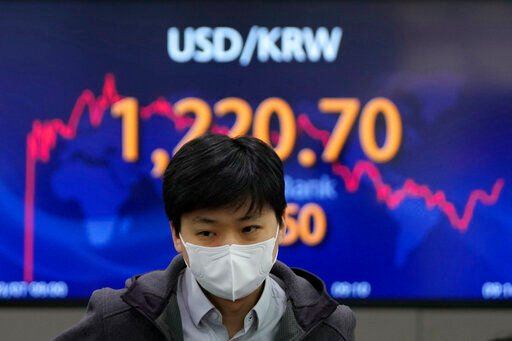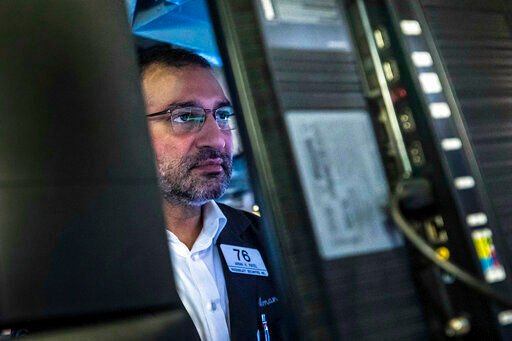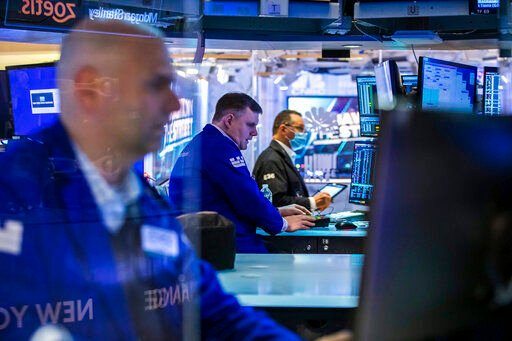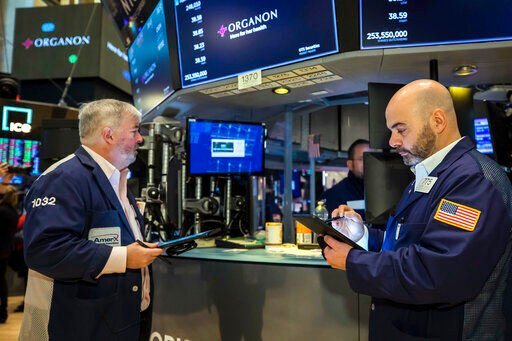NEW YORK (AP) — Wall Street had its biggest drop in more than a year Monday as another leap for oil prices threatened to squeeze inflation’s grip on the global economy.
The S&P 500 fell 3%, its biggest decline in 16 months, after a barrel of U.S. oil surged to $130 overnight on the possibility the U.S. could bar imports from Russia. Stocks around the world also fell earlier in the day, taking their cue from oil’s movements.
The benchmark S&P 500 fell 122.78 points to 4,201.09. The Dow Jones Industrial Average fell 797.42 points, or 2.4%, to 32,817.38.
The Nasdaq composite slid 482.48 points, or 3.6%, to 12,830.96. The tech-heavy index is now 20.1% below its record set in November. Such a decline means the index is now in what Wall Street calls a bear market. The S&P 500 is down a more modest 12.4% from the peak it set in early January.
Gold and a measure of nervousness on Wall Street also rose, though not by quite as much as when oil prices hit their peak. The price of gold briefly rose above $2,000 an ounce before settling at $1,995.90, up 1.5%.
“This could be something that drags on for a while as the tensions in Ukraine persist, as oil prices remain elevated,” said Sam Stovall, chief investment strategist at CFRA. “The higher and longer oil prices stay elevated, the greater the eroding impact that they will have on economic growth.”
Oil prices have soared recently on worries that Russia’s invasion of Ukraine will upend already tight supplies. Russia is one of the world’s largest energy producers, and oil prices were already high before the attack because the global economy is demanding more fuel following its coronavirus-caused shutdown.
U.S. House Speaker Nancy Pelosi said in a letter to her colleagues on Sunday that “the House is currently exploring strong legislation” to further isolate Russia because of its attack on Ukraine. That could include a ban on imports of Russian oil and energy products, she said.
It’s a major step that the U.S. government has not yet taken, despite a long list of moves to punish Russia, as the White House has said it hopes to limit disruptions to oil markets. It wants to limit price jumps at the gasoline pump.
Reports also said U.S. officials may be considering easing sanctions against Venezuela. That potentially could free up more crude oil and ease concerns about reduced supplies from Russia.
A gallon of regular already costs an average of $4.065 across the country after breaching the $4 barrier on Sunday for the first time since 2008. A month ago, a gallon averaged $3.441, according to AAA.
A barrel of U.S. crude oil settled at $119.40 per barrel, up 3.2%, after earlier touching $130.50. Brent crude, the international standard, settled at $123.21 per barrel, up 4.3%, after earlier topping $139.
Meanwhile, smaller company stocks also fell sharply. The Russell 2000 index fell 49.57 points, or 2.5%, to 1,951.33.
Markets worldwide have swung wildly recently on worries about how high prices for oil, wheat and other commodities produced in the region will go because of Russia’s invasion, inflaming the world’s already high inflation. In the United States, prices for consumers jumped last month from their year-ago level at the fastest rate in four decades.
The conflict in Ukraine also threatens the food supply in some regions, including Europe, Africa and Asia, which rely on the vast, fertile farmlands of the Black Sea region, known as the “breadbasket of the world.”
The war puts extra pressure on central banks around the world, with the Federal Reserve on course to raise interest rates later this month for the first time since 2018. Higher rates slow the economy, which hopefully will help rein in high inflation. But if the Fed raises rates too high, it risks forcing the economy into a recession.
“Their reaction to geopolitics can’t really be measured, so there’s uncertainty around that,” said Sameer Samana, senior global market strategist at Wells Fargo Investment Institute.
Some investors have seen the war in Ukraine as potentially pushing the Fed to go easier on rate increases. Investors love low rates because they tend to boost prices for stocks and all kinds of markets.
But that may not necessarily be the case this time, Goldman Sachs economists wrote in a report. With prices for oil, wheat and other commodities potentially rising even more, the threat is higher for a sustained, high inflation to settle on the economy. That could flip the Fed’s traditional playbook.
“After several decades in which economic, financial, or political shocks invariably caused interest rates to fall, markets may have to re-learn that the opposite can also be true,” Goldman Sachs economist Jan Hatzius wrote.
Beyond sanctions brought on Russia by governments because of its invasion of Ukraine, companies are also levying their own punishments. The list of companies exiting Russia has grown to include Mastercard, Visa and American Express, as well as Netflix.
The value of the Russian ruble continued to slide amid all the financial pressure, falling 12% to 0.7 cents.
Treasury yields climbed. The 10-year yield rose to 1.78% from 1.72%.
———
AP Business Writers Damian J. Troise and Yuri Kageyama contributed. Veiga reported from Los Angeles.







